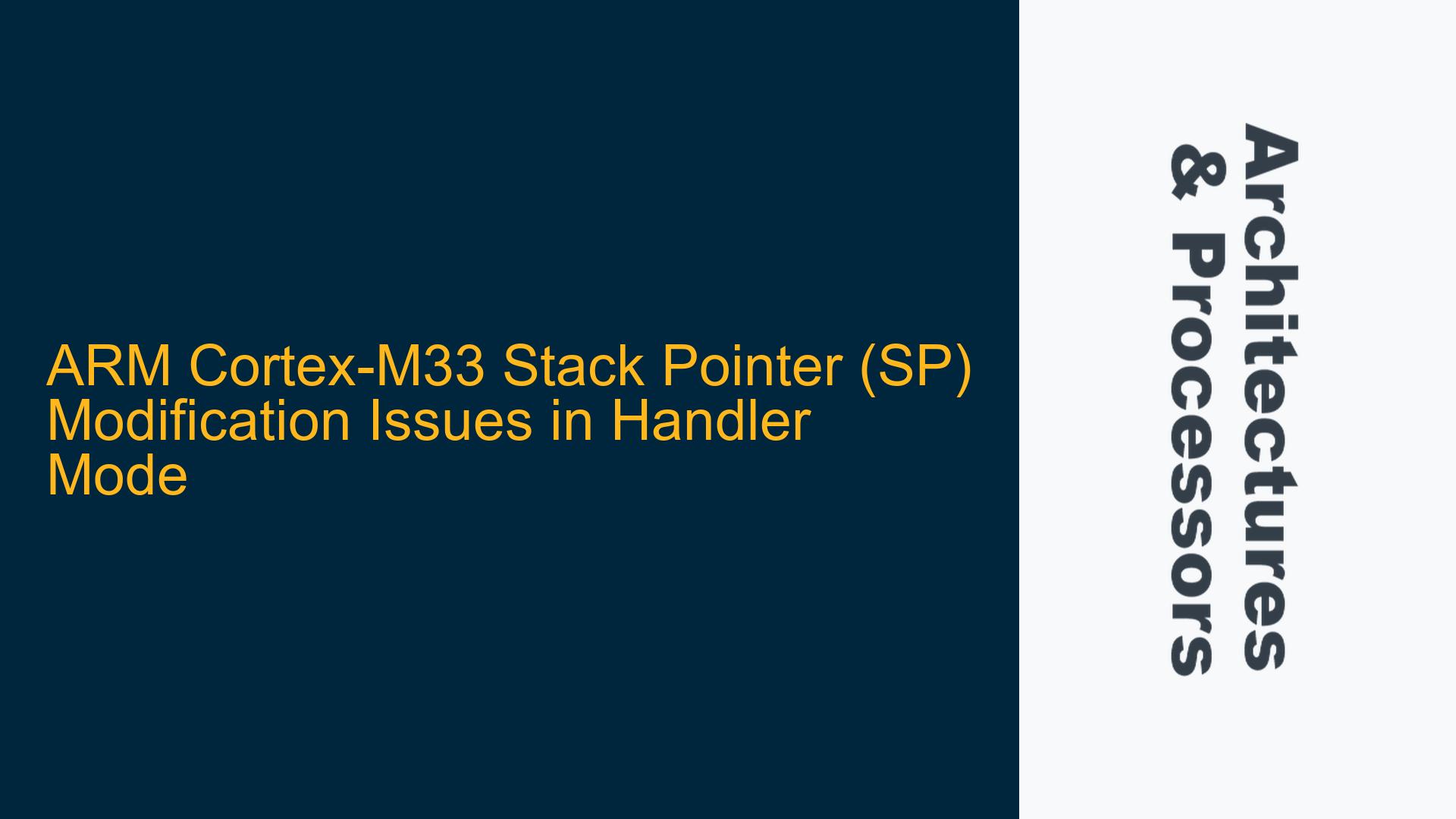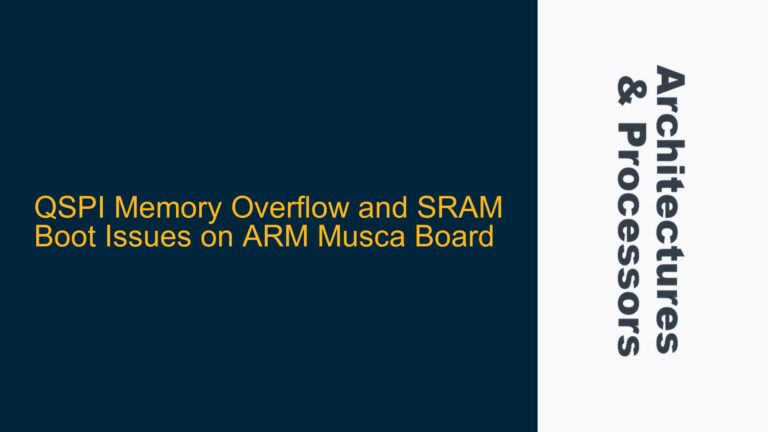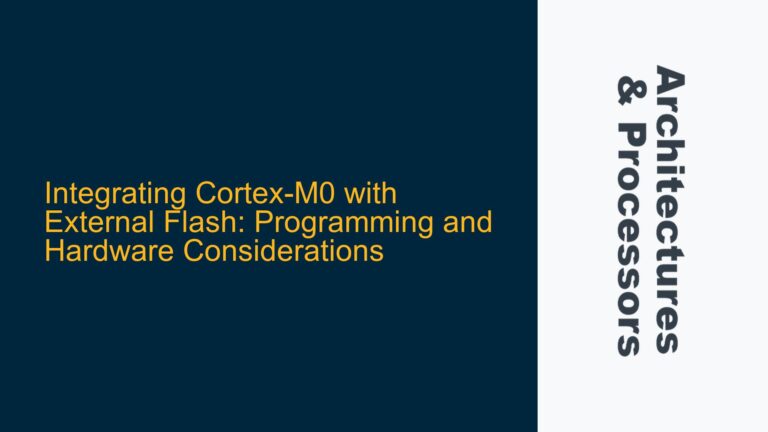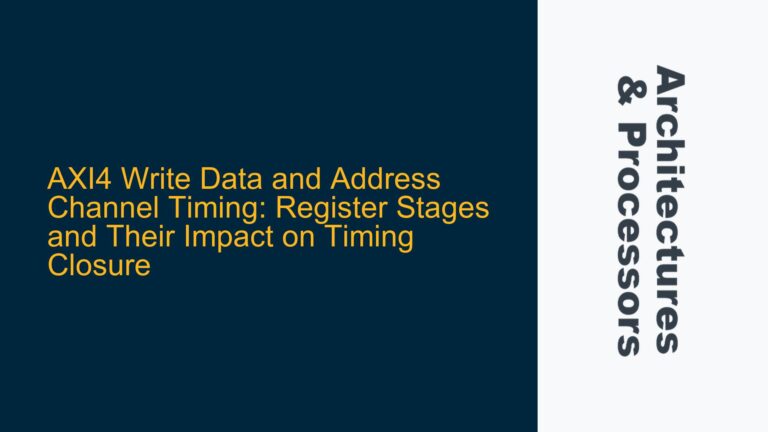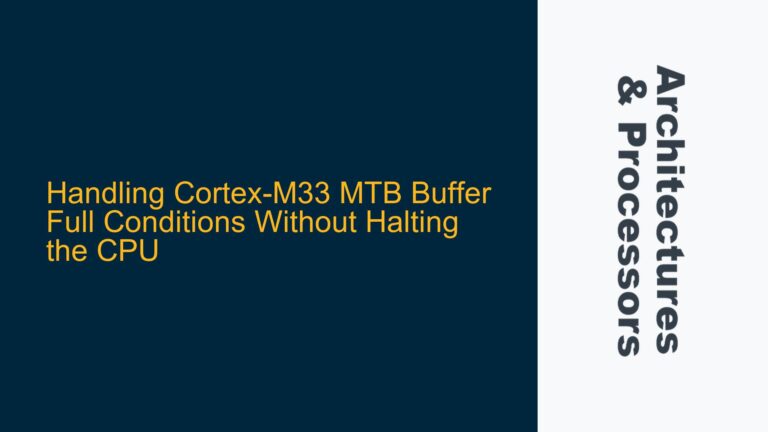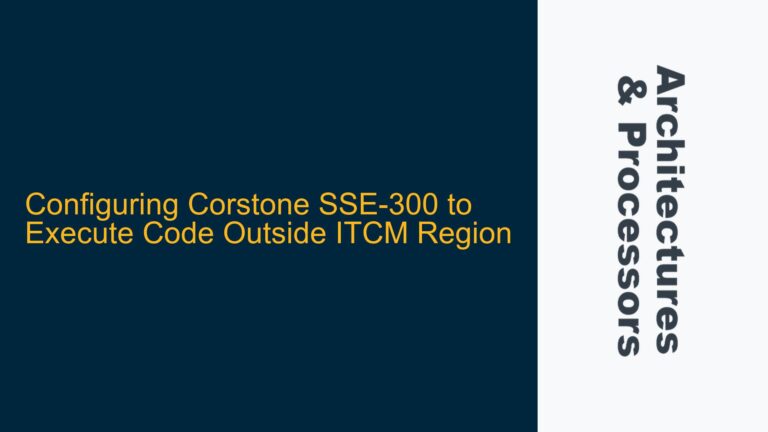ARM Cortex-M33 Stack Pointer (SP) Modification Issues in Handler Mode
Understanding the Context: SP Modification in Handler Mode for Fault Recovery
In embedded systems, particularly those utilizing ARM Cortex-M series processors, the Stack Pointer (SP) plays a critical role in managing function calls, local variables, and interrupt handling. The ARM Cortex-M33, being a member of the Cortex-M family, employs two stack pointers: the Main Stack Pointer (MSP) and the Process Stack Pointer (PSP). The MSP is typically used in Handler mode (e.g., during exceptions and interrupts), while the PSP is used in Thread mode for application tasks.
A common scenario where SP modification becomes necessary is during fault recovery. When a fault occurs, the processor enters Handler mode, and the MSP is used by default. To debug or recover from the fault, developers often need to manipulate the SP to access the call stack or restore the system to a known state. However, modifying the SP in Handler mode is not straightforward and can lead to issues such as lockups or compilation errors if not done correctly.
In the case of the ARM Cortex-M33, the user attempted to modify the SP within a HardFault Handler to recover the call stack of a faulty application. The user tried various methods, including direct MOV instructions and the MSR (Move to Special Register) instruction, but encountered either compilation errors or system lockups. This highlights a critical challenge in embedded systems development: understanding the constraints and proper usage of stack pointers in different processor modes.
Root Causes: Misuse of SP Modification Instructions and Mode-Specific Constraints
The primary issue stems from the misuse of instructions for modifying the SP and a lack of understanding of the ARM Cortex-M33’s mode-specific constraints. Below are the key factors contributing to the problem:
-
Incorrect Use of MOV SP, Rn Instruction:
The user attempted to use theMOV SP, R0instruction to set the SP to a new value. While this instruction is valid in some contexts, it does not work as intended in Handler mode on the Cortex-M33. The Cortex-M33, like other Cortex-M processors, has specific rules for accessing and modifying the SP. In Handler mode, the MSP is active, and direct modification of the SP usingMOV SP, Rncan lead to undefined behavior or system lockups. -
Misapplication of MSR SP, Rn Instruction:
The user also tried using theMSR SP, R0instruction, which resulted in a compilation error. This is because theMSRinstruction requires a specific register name (e.g., MSP or PSP) rather than the generic "SP". The Cortex-M33 architecture does not support theMSR SP, Rnsyntax, as the SP is not a directly addressable special register in this context. -
Handler Mode Constraints:
In Handler mode, the Cortex-M33 uses the MSP by default. Any attempt to modify the SP must respect this constraint. The user’s code attempted to switch to using the PSP in Handler mode, which is not a standard practice and can lead to instability. TheCONTROLregister, which determines the active stack pointer, should only be modified in Thread mode, not Handler mode. -
Toolchain-Specific Behavior:
The user encountered different behaviors depending on the toolchain used (e.g., Arm Compiler 6). Some toolchains may allow certain instructions to compile but fail during execution, while others may reject the instructions outright. This variability underscores the importance of understanding toolchain-specific nuances when working with low-level code.
Resolving the Issue: Proper Techniques for SP Modification in Handler Mode
To address the SP modification issue in Handler mode on the ARM Cortex-M33, follow these steps:
-
Use the Correct MSR Syntax:
Instead of usingMOV SP, RnorMSR SP, Rn, use the correct syntax for modifying the MSP or PSP. In Handler mode, the MSP is active, so the appropriate instruction isMSR MSP, Rn. For example:MSR MSP, R0 ; Set MSP to the value in R0This ensures that the MSP is updated correctly without causing a lockup or compilation error.
-
Avoid Modifying the CONTROL Register in Handler Mode:
TheCONTROLregister should only be modified in Thread mode. Attempting to switch from MSP to PSP in Handler mode can lead to unpredictable behavior. If you need to switch stack pointers, ensure that the processor is in Thread mode before making the change. -
Validate Stack Pointer Values:
Before modifying the SP, validate the new value to ensure it points to a valid memory region. An invalid SP value can cause a system lockup or memory access violations. For example:LDR R0, =ValidStackAddress ; Load a valid stack address MSR MSP, R0 ; Set MSP to the valid address -
Use Separate Assembly Files for Complex Operations:
If inline assembly is causing issues, consider moving the assembly code to a separate file. This approach can help avoid toolchain-specific limitations and improve code readability. For example, create a file namedstack_ops.swith the following content:AREA STACK_OPS, CODE, READONLY EXPORT SetMSP SetMSP MSR MSP, R0 ; Set MSP to the value in R0 BX LR ; Return to caller ENDThen, call this function from your C code:
extern void SetMSP(uint32_t newSp); SetMSP(ValidStackAddress); -
Debugging and Testing:
After implementing the changes, thoroughly test the code to ensure it behaves as expected. Use a debugger to step through the assembly instructions and verify that the SP is updated correctly. Monitor the system for any signs of instability or lockups. -
Consult the ARM Architecture Reference Manual:
The ARM Architecture Reference Manual provides detailed information on the Cortex-M33’s stack pointer behavior and instruction set. Refer to this document for authoritative guidance on SP modification and other low-level operations.
By following these steps, you can safely and effectively modify the SP in Handler mode on the ARM Cortex-M33, enabling robust fault recovery and debugging capabilities in your embedded applications.
Summary of Key Points
| Key Point | Description |
|---|---|
Use MSR MSP, Rn in Handler Mode |
Directly modify the MSP using the correct MSR syntax. |
Avoid MOV SP, Rn in Handler Mode |
This instruction can cause lockups or undefined behavior. |
| Do Not Modify CONTROL in Handler | Switching stack pointers should only be done in Thread mode. |
| Validate SP Values | Ensure the new SP points to a valid memory region. |
| Use Separate Assembly Files | Move complex assembly operations to separate files to avoid toolchain issues. |
| Test Thoroughly | Use a debugger to verify SP modifications and system stability. |
By adhering to these guidelines, developers can avoid common pitfalls and ensure reliable SP manipulation in ARM Cortex-M33-based systems.
